Algae: Miraculous Single-Celled Creatures That Give Off Oxygen
Some living things possess rings containing pigments. The characteristic of these is that electrons can move freely around them. The ring in question can therefore easily acquire or lose an electron, and thus immediately trap light and energy around it. The solar energy reaching the Earth is one form of energy with which that the pigment can interact. This pigment, which traps and absorbs solar energy is known as chlorophyll, which permits living things to perform photosynthesis.
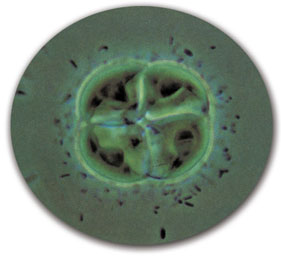 |
This alga seen during photosynthesis meets one of the principle requirements of life: Oxygen and food. |
Neither human beings nor animals can perform photosynthesis, because they contain no chlorophyll. Nor can this process be carried out artificially in laboratories. The mechanisms that take place in the chlorophyll pigment are exceedingly complex and are not yet fully understood. Apart from green plants and the photosynthetic bacteria we have already discussed, only algae can perform photosynthesis. They meet their own energy needs by way of photosynthesis, and meet the major requirements of the Earth. Algae absorb some 30% of the carbon dioxide gas and meet 70% of the planet's oxygen needs.67 They also provide 70% of the food requirements of all living species. They possess not only the capability of photosynthesis, but special mechanisms that permit solar rays to be transported to regions that never see any light. 68
These microorganisms have no brains and cannot think or reason. They consist of just one or a few cells that can be seen only under a microscope. However, algae meet the ecosystem's most important needs—oxygen and food—with a microscopic factory specially created for them.
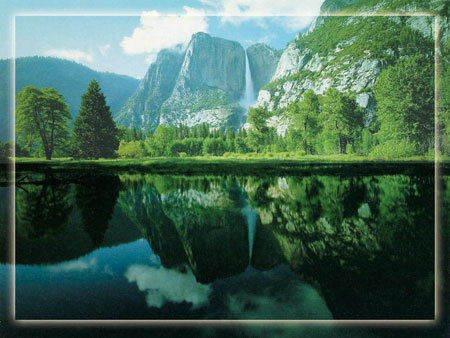 |
Algae possess a perfect mechanism that no human being has yet been able to produce under special conditions. Thanks to the chemical factory in their single-celled bodies, they are able to make photosynthesis. This fact alone is sufficient for us to see and comprehend the greatness of Allah. |
Algae are widely found in shallow waters, and can live on every water surface that receives sunlight: from thermal springs to the surfaces of ice and snow. The algae cell consists of two sections, one colored and one not. DNA and, in some species, the nucleus are found in the non-colored part, while the other portion contains RNA and color giving pigments.
The kind of pigment contained by particular algae groups differs from others depending on their cell walls and mobility. Algae containing only chlorophyll may be green or blue-green. Brown and red algae contain not only chlorophyll but also such pigments as carotene that conceal the green.69 Algae possess a thin and rigid cell membranes. Some algae move with tiny hairs known as flagella. The cell contains a complex nucleus. The chlorophyll is covered in, and protected by, a special membrane that carries out the photosynthetic reactions with light.
Another of the important processes performed by algae is to produce large amounts of organic substances in the water around them, thus increasing the food available to water-dwelling organisms. Water containing algae is therefore very well suited for other forms of life. Algae also clean the water they live in. Some have constructive properties that actually change the form and nature of the shore and sea beds. Providing food and nutrients for living things, they constitute the basis of the food chain in the oceans.
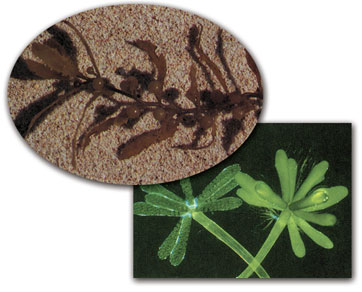 | 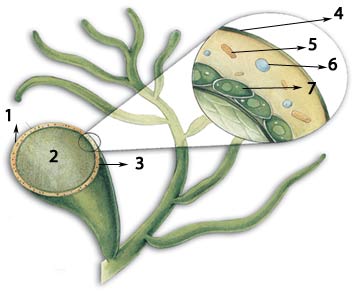 | |
1.4. Cell wall, | 4. Cell wall, | Left: Algae can be green and turquoise, containing chlorophyll, or else brown and red. Right: Algae have a thin, solid cell membrane and a complex nucleus. The chlorophyll is protected with a special membrane that carries out the photosynthesis light reaction. |
Some algae use light and CO2 as their basic fuels. Others feed by producing complex organic substances from simple ones. For example, the energy from the Sun reaching the surface of the Atlantic Ocean on a summer day is around 2 billion calories. Some 99.5% of this energy is reflected and scattered. Only 1.67 million grams (0.5%) is used by single-celled algae to produce food. Algae absorb 32% carbon dioxide and dissolve and expel the remaining 8% in the form of organic substances.70 That level of 8% is needed by the planet as organic matter, which is transmitted to other living things.
 |
In providing their own nutrients, algae also produce energy. The energy they produce is at the level essential for life. |
Algae are used by industry in many ways—directly in the manufacture of foodstuffs, drugs and other industrial products, and also play a significant role in the manufacture of other goods. These products are in turn used to manufacture various foods, medical and cosmetic products.71 Allah has made this minute entity exceedingly useful—another important proof of the greatness of Allah, our Almighty Creator.
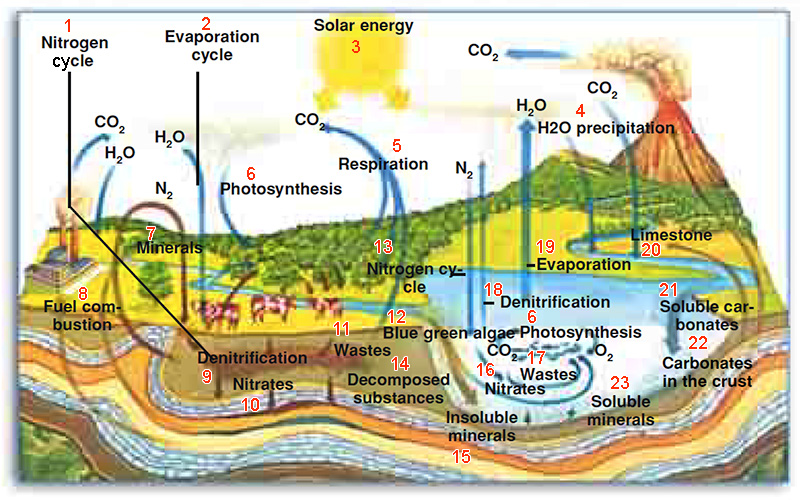 |
Thanks to the chemical processes they perform, algae are the main cause of energy transformations and temperature stability. The abilities they possess are beauties displayed in living things by Allah and placed at the disposal of human beings. |
Algae Maintain a Steady Climate
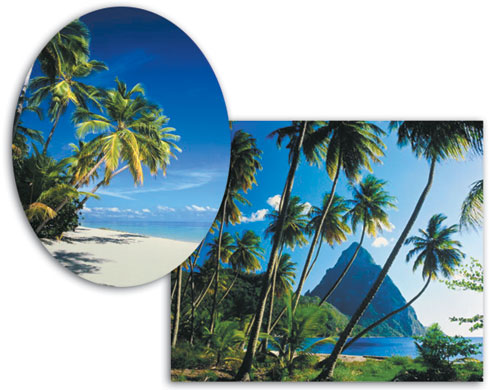 |
And you see the ships cleaving through it so that you can seek His bounty, and so that hopefully you will show thanks. (Surat an-Nahl, 14) |
Whilst part of the energy reaching the oceans from the Sun is reflected, a very small part is used by algae. The food algae produce using this energy provides the organic substances needed by all living things. |
A great many algae produce a gas known as dimethyl sulphate (DMS). This gas, as we have already briefly touched on, turns into solid particles by reacting with oxygen immediately above the sea, leading to cloud formation. Thus algae are responsible for forming clouds that reflect radiation from the Sun, keeping the planet cool, at its present temperature. Therefore, algae possess the effective important property of maintaining the temperature of the planet.
It is impossible for evolutionist biologists to understand this system and still account for it in terms of evolution. The theory of evolution can not explain a single-celled organism's effect on atmospheric conditions and the maintaining of Earth's temperature. Moreover, the mechanism that algae employs represents an even greater puzzle for evolutionists.
The activity of algae increases as the atmosphere warms up, and they begin producing DMS. The way and reason why algae produce this substance is still not yet fully understood. According to one view, DMS is a waste product given off by the cells. According to another claim, when cells are damaged, they release a toxic acid to defend themselves from enemies. Algae exposed to attack by viruses or plankton thus release large quantities of DMS. Even if this hypothesis is confirmed, it is still not yet known why algae release large amounts of this substance at some times and smaller amounts at others, apparently in response to need. Algae vary their production levels in line with temperature, with the aim of keeping the world cool: Algae to produce more DMS in tropical regions, and less of it in colder ones.
Were it not for these organisms, the Earth would be a much warmer place. Indeed, as a result of them, a cooling of up to 40 degrees takes place on our planet. If it did not, the upper levels of the oceans would rapidly warm, separating from the cooler ones below, making it impossible for surface algae to reach the nutrients below. For that reason algae release this substance which exhibits antifreeze properties. But why should organisms living in tropical oceans need to manufacture antifreeze?
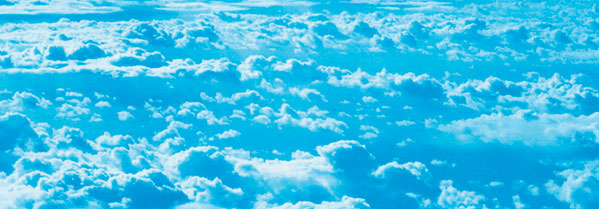 |
And We shaded you with clouds. . . . (Surat al-Baqara, 57) |
Algae need to produce antifreeze because with this substance, they can rise into the air when water evaporates. Algae climb into the upper layers of the atmosphere, helping them spread to more distant regions by air currents that effectively carry them all over the planet. That the sky is full of these organisms is thus not at all surprising. There are up to 10.000 microorganisms, of various species, in every cubic meter of air in the layer closest to the Earth.
 |
The gas DMS produced by algae enters into a reaction with the oxygen just above the sea and gives rise to clouds. |
Up to a height of 50 kilometers (31 miles) in the atmosphere, there are living bacteria and fungi using the same method as algae, accelerating the photosynthesis of the algae on the Earth. As a result of photosynthesis, when the water surface warms up, bubbles form on the surface. Algae—just as if they knew that these bubbles would soon burst and expel themselves into the atmosphere, install themselves inside. When the bubble bursts, the algae leave the water and can enter the air, where they can move freely.
As DMS forms, it emits heat energy that warms the air around it. And this warm air rises. The air beneath is pulled upward by and the current that forms constitutes clouds. In this way, the algae on the water surface rise up with air currents and use wind in order to spread. The algae that rise into the air are red—another important point, since their color protects them from ultraviolet rays when they ascend into the atmosphere. 72
All this system we have described clearly shows that such a minute organism possesses all the requirements and mechanisms to spread all over the planet. The way that a minute living thing influences the temperature of the atmosphere and permits all life to survive is clear evidence of special Creation. Moreover, what is astonishing is the fact that everything consists of gas production, that this gas reaches the highest strata in special ways, that it causes clouds to form and, even more importantly, that this microorganism assists in these processes. As you have seen, evolutionists are baffled in the face of these phenomena, because a microorganism affecting the entire ecosystem in an organized fashion leaves the simple and illusory mechanisms of evolution far behind.
Diatoms: A Special Kind of Algae
 |
Diatoms covered with silesium display an extraordinary symmetry and beauty. The exhibition of such flawless and geometrical artistry in these microorganisms shows the full glory of Allah's infinite might. |
Diatoms are algae that generally live in water and also possess the ability to perform photosynthesis. Diatoms represent 90% of the living organisms in the oceans. There are also freshwater varieties of diatoms.
Diatoms possess a double shell that is hard because it contains silesia, for which reason diatoms' forms are impressive and rather attractively arranged. They are divided in two symmetrically by a line running down their middles. Each symmetrical half contains other symmetrical figures. This symmetry exhibits a flawless geometry, a marvel of superior Creation. Diatoms are all works of art, displaying the most flawless structure among microorganisms. Their different shapes have measurements calculated with the greatest care, showing that these living things are the matchless work of a sublime Creator. In these terms, diatoms are all works of art, with the most flawless and symmetrical structure among microorganisms.
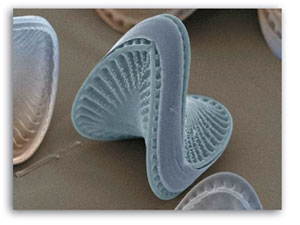 |
he way that a single-celled creature with just a cell membrane and chloroplast can function just like a chemical laboratory and exhibit such superb artistry amazes believers and leaves evolutionists in despair. |
Some 10.000 living and 15,000 extinct species of diatom have been described. Along with other photosynthetic algae, they constitute the food chain of the tropical oceans. They are responsible for the annual production of 130,000 tons (286,600,000 pounds) of organic carbon, the basic nutrient of living things and whose production is most important for the world's ecology. Through their process of photosynthesis, diatoms are among the major consumers of carbon dioxide.
This living things, which produce their own food by photosynthesis and permits the release of free oxygen, are only some 25 microns in size. The other benefits provided by this microorganism may be summarized as follows. Diatoms represent an important food source for marine creatures like fish and whales. At the same time, they are responsible for providing the vitamin D in fish oil, very valuable for human development. Allah created this tiny creature out of compassion for fish, and for human beings who use fish as food.
In addition, diatoms also have industrial uses in filtering and insulation. These organisms are particularly important in transforming silica, nitrate and phosphate to a state that can be used by living things.73 They can even be used for purifying undrinkable water springs.
Most of these processes cannot be carried out under even modern-day laboratory conditions. But the way a single-celled diatom functions just like a chemical laboratory is of course none of its own doing. Unaware of the carbon dioxide outside, the oxygen it produces, or the importance of the vitamin D in fish oil, it merely fulfils the functions assigned to it. Its superior attributes and behavior are inspired by Allah, Who created it, as well as the Earth and sky and everything in them, with His simple command Be!
Our Word to a thing when We desire it is just to say to it, "Be!" and it is. (Surat an-Nahl, 40)
Algae Share a Life with Other Living Things
Corals Survive As A Means of Algae
Coral shares its life with algae in order to survive. The single-celled algae that settle on the coral's surface lend it its beautiful colors and at the same time permit it to feed. Algae accelerate the formation of the lime necessary for the development of coral reefs and also protect the surface of these polyps from the erosive effects of salt water.
The most evident manifestation of this symbiosis between coral and algae can be seen in the lovely coral that give the Red Sea its color, as a result of this communal life.
The Red Sea, situated between two deserts, should be a most infertile region. The climate is dry, and there are no rivers or freshwater sources to feed the sea. The sea therefore possesses no sources to generate oxygen or nitrogen. Under normal circumstances the Red Sea should harbor very little life. In fact, however, that coral survives easily in this unfavorable environment, and also permits other organisms to live in it.
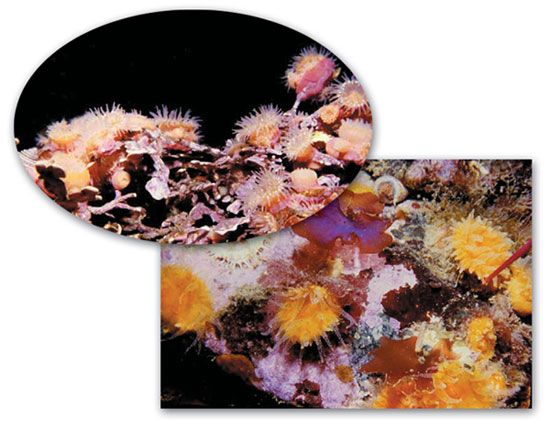 |
The main element allowing coral to survive is green algae. Algae sheltering on the surface of coral provide easy food for it thanks to the photosynthesis they carry out. |
Green algae are the only elements that permit coral to survive in these waters with no other life source. The coral gives the algae a place to shelter inside itself, and thanks to the photosynthesis they perform, the algae provide the coral with food and energy. Coral uses all kinds of methods in order for algae to receive sunlight, their all-important source of energy. For that reason, coral polyps generally closes in on themselves in the daytime, leaving only their exoskeletons outside. In this way, the sunlight easily reaches the algae within, permitting the process of photosynthesis. In this way, the coral also obtains the food it needs.
Coral meets all its food requirements with a system peculiar to itself. These polyps secrete a digestive solution that weakens the skin of the algae. By this method, 80% of all the nutrients photosynthesized by algae emerge and enter the coral's own cells.74 This method employed by coral is a thoroughly planned one. Coral knows that algae represent a rich food source, and for that reason, it does not permit all the algae to die when it releases the dissolving substance to obtain the nourishment it needs. The amount released is just enough to assist the required amount of nourishment to be released.
 |
In order for the algae they shelter to benefit from the Sun, coral closes in on itself during the day to expose the algae. This makes the process of photosynthesis easier. |
The process of photosynthesis performed by algae also enriches oxygen content of the sea water. Oxygen-enriched water broadens the chain of life. The nitrogen level also rises, thanks to animal wastes and bacteria, making for an increase in fertility and life. That is also the reason why there is life in the Red Sea. Algae, too, benefit from this relationship, of course. Under normal conditions, coral gives off ammonia and CO2. These substances are a perfect source of fertilizer, and food for algae. At the same time, algae need nitrate and phosphate in order to survive, which substances are found in coral waste products.75 Coral has wastes, because as you know, coral is an animal, and not a plant. Therefore, all the raw materials necessary for algae to live are present in the coral's tissues. The algae obtain all the food they need, without expending any effort, from this invertebrate on which they live, which also protects them from enemies.
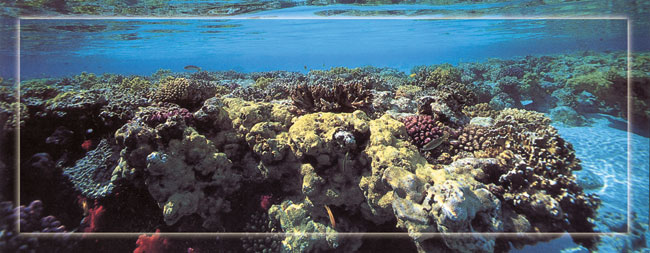 |
The two seas are not the same: the one is sweet, refreshing, delicious to drink, the other salty, bitter to the taste. ..(Surah Fatir, 12) …Yet from both of them you eat fresh flesh and extract ornaments for yourselves to wear. (Surah Fatir, 12) |
The methods developed by coral to provide sunlight for algae exhibit an obvious planning. Corals generally anchor themselves in places in the sea where there is strong sunlight, and especially in shallow waters. They spread out more thinly in deeper waters where sunlight is less, and settle into shape in such a way as to obtain the maximum amount of light in their environment. In this way, the algae obtain their most important source of energy. Clearly, coral is very well acquainted with algae and know what they need. Yet to claim that coral, a sea animal, and algae, a single-celled organism, are acquainted with one another is to claim that they exhibit conscious behavior. It is definitely impossible for coral to know that algae survive by taking energy from the Sun. It's equally out of the question for coral to think of using this property for its own benefit. In addition, it's impossible for coral to think of dissolving the algae's cell membrane to make greater use of them, and to locate in a special place in the water in order for algae to make greater use of sunlight. Yet these two symbiotic organisms are well acquainted with one another, and we must admit that the impossible has happened and that both behave in a seemingly conscious manner. Therefore, we once again see the manifestations of Allah's omniscience and realize that the idea of chance development is a huge misconception.
 |
We have honored the sons of Adam and conveyed them on land and sea and provided them with good things and favored them greatly over many We have created. (Surat al-Isra', 70) |
The benefits that algae confer on coral go even further. In a yet undetermined way, algae permit the coral skeleton to grow. This is a most important assistance because coral polyps can live only if they can form their own exoskeletons. Algae also produce a chemical substance that functions like a high-factor sun cream to protect both themselves and the polyp they live on from harmful ultraviolet rays. This substance is of great importance since it especially manufactured in tropical regions where the Sun's rays are very strong.76
A tiny algae cell is able to take a precautionary measure, as if it knew the harmful effects of too much ultraviolet light, and uses chemical methods to do this. Looked at from all these aspects, this common life the details of which we have been looking at is the best and most advanced symbiosis in the world. Coral can survive at a maximum temperature of 290C. When the water reaches 340C, coral casts off the algae on its surface. This reaction is the first step in the death of the coral. If the temperature rise persists for four weeks, it becomes impossible for the coral polyps to find the algae necessary for them to survive. 77
Sponges and foreign algae later settle in the emptied-out coral skeleton. But the algae leaving the coral with which they shared a common life also take with them the coral's beautiful colors, so that the coral turns brown and green. Coral that has lost all its bright hues, is also deprived of its protective algae and is now exposed to the corrosive effects of salt water. All that now remains of the original coral is its calcium and inorganic albumins.
Under the effect of passing years and the erosion caused by the water's movement, coral turns into sand. If the temperature rise persists for four weeks, it becomes impossible for the coral to find the algae necessary for them to survive.78
Algae Allow Jellyfish to Live
 |
Under normal circumstances jellyfish feed on small fish. In seas where food is scarce, however, their only food source is algae. They way they recognize and store these in their bodies as a food depot is literally conscious behavior. |
Masses of water produced by seas of parts of seas in certain regions of the sea are very impoverished in terms of food. Like coral, the jellyfish that live in such regions start looking for algae to absorb into their bodies, as if they knew where to find the nutrients they require. Under normal conditions, jellyfishes feed by catching small fish and crustaceans with their tentacles. That is impossible in infertile seas, however, which is why they embark on a shared life with algae. They detect algae with their tentacles and absorb them into their bodies without digesting them.
To obtain the necessary energy, jellyfishes head straight for the surface of the water, the region receiving the greatest amount of solar energy in the early morning. As the Sun travels from East to West in the sky, jellyfishes also follow its movement and face the direction of the Sun. A very large community of jellyfish can form a vertical wall extending up to 700 centimeters (22.97 feet) deep forms in the area where solar light strikes the water. If a beam of sunlight occurs between objects in the waters, jellyfishes make the most of the opportunity and line themselves along the beam in such a way that every one can see the sunlight. In short, wherever the Sun is, there the jellyfishes are, to obtain the energy necessary to nourish themselves by means of photosynthesis. In darker waters that do not receive sunlight, no trace of jellyfishes can be found. As the Sun sinks, the jellyfish come to the centre of the water they are in. When darkness falls, they feed on nitrates they produce themselves or find in the water.
Amaç sadece kendilerini besleyen fotosentetik canlılara gerekli olan enerjiyi sağlayabilmektir. Aynı bölgede güneş almayan karanlık sularda ise denizanalarından eser yoktur. Güneş iyice battığında denizanaları bulundukları su kütlesinin merkezine gelirler. Karanlık bastığında ise algleri, kendi ürettikleri veya suyun içinde bulunan nitratlarla beslerler.
In order to do all these extraordinary and completely rational things, jellyfish have been equipped with sense organs capable of detecting light at high and low concentrations. 78These enable them to make their daytime migrations to the brighter light in the water. The fact that a jellyfish has a delicate, light-sensitive system from which its symbiotic relationship benefits is not something to be ignored. Jellyfish never mistakenly absorb any other organism or a different species of algae into their bodies, only those species that will be of use. Jellyfishes have no eyes or brain, and consist largely of water. They need to establish whether there is a chloroplast in the living cell they touch. The way that they carry it straight towards the Sun instead of feeding on other organisms around them, shows that they know what will nourish the algae cells they have absorbed into themselves. Jellyfishes have known the properties of algae for millions of years. The way they use them for their own benefit reveals the existence of Allah's extraordinarily superior creative artistry.
Algae Provide Protection for Slugs
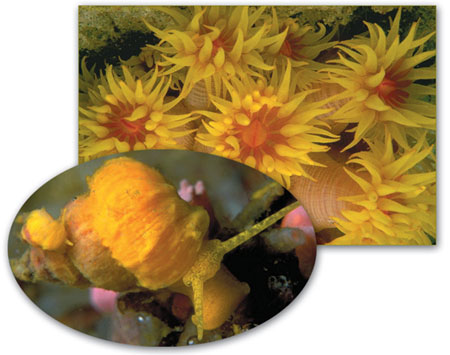 |
These creatures that feed with corals separate the algae in the coral tissue as they digest it and keep the algae alive. The slug possesses a special mechanism to enable it to do this. It moves the algae cells it ingests from its stomach toward the tentacles on its outer surface and enables the algae to remain alive there. In this way, the defenseless sea slug is provided with perfect camouflage.79 The sea slug has now changed color thanks to the algae it has absorbed into its body and is much harder for predators to recognize.
Can a sea slug see colors? Is it aware of what color the coral is, and can it imagine that it will be inconspicuous to predators by assuming that color? How can it know that the algae gives coral its color and that it needs to separate out the algae from the foods it eats? How does it keep them alive in its body and move them to its extremities? In order to establish this technique, it must first calculate by what means it can avoid danger, then identify the source of the color in the coral, produce enzymes that prevents the algae from being digested, and develop a mechanism for transporting the algae that extends through its body. These are exceedingly complex and scientific processes that require long research and study by humans, yet they are performed very easily by a sea slug unaware of its own existence and other things around it, at every moment and by all other members of that species. This tiny living thing succeeds in all these miraculous processes that human beings cannot perform, and is one of the proofs of the absolute existence of Allah. It draws people who know and appreciate Allah closer to Him. It also deals a major blow to the Darwinism that seeks to conceal the existence of Allah from people and that deifies coincidences.
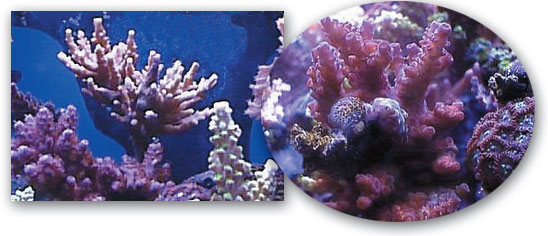 |
A sea slug shell almost entirely covered with coral |
Other Living Things that Algae Benefits
 |
Flamingos are the colors of the algae they eat. |
The flamingos we are used to perceiving as red actually draw their color from a very particular source: Algae. The algae that flamingos eat endow them with their own unique color. The algae that enter the bird's body spread all through it and impart their color to its feathers. 80
In addition, algae assist with the feeding of large sea combs. Zooxanthellae a small species of algae, is a microorganism that can live only in the bodies of other living things. It regards the sea comb as the safest place for it. Large sea combs provide these tiny, green algae with a comfortable environment in which to live and protect them from enemies. In addition, the sea combs provide the algae with such nutrients as carbon dioxide, nitrogen and phosphorus. In return, of course, substances produced by Zooxanthellae constitute the main foodstuff of the sea combs. 81
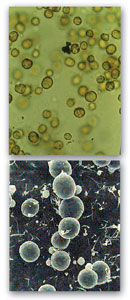 |
Zooxanthellae |
The proponents of the theory of evolution have advanced a number of scenarios about algae. According to the most widely accepted tale, algae are a primitive form of life that evolved and enabled plants to emerge. Here, the evolutionist obsession that we can summarize as "What is ancient and small is primitive" reveals itself here. As you saw earlier, the bacteria and viruses that evolutionists describe as "primitive" possess astonishing features and complex mechanisms; and algae assume vital functions in the continuation of life on Earth. These points are either glossed over or never mentioned at all in evolutionary scenarios.
There are fundamental questions to which the adherents of the theory of evolution have to give concrete replies. According to scientific research, algae emerged suddenly, in the form they possess today, some 3.5 billion years ago on rocks in South Africa. Like algae, bacteria also appeared suddenly in the same period and bear the same features now as they did then. No primitive entity that can be proposed as the ancestor of these living things ever existed. The fact is, these microorganisms have existed in the same form for billions of years, unchanged down to the present day. They never underwent evolution at any time.
Algae are one of the Earth's sources of oxygen and also a food resource, superior marvels of Creation that provide a number of benefits for all living things, from the smallest entities in the sea to the largest animals on land, and even for human beings. Not only do they keep themselves alive, they also enter the bodies of other living things and perform useful functions for them. All this is great and incomparable proof for those who wish to see the absolute existence of Allah. On this subject Allah reveals:
Allah Who creates as He creates, so that all creating seems the same to them?' Say: "Allah is the Creator of everything. He is the One, the All-Conquering." (Surat ar-Ra‘d, 16)
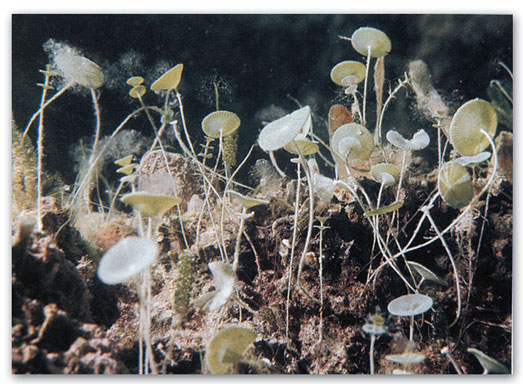 |
From the smallest to the largest, algae, a source of food and oxygen, are a superior marvel of Creation that provide benefits for living things. |
Footnotes
67- Nathaly Nicolas, Le Placton, L'océan et Les Hommes, Ça M'Intéresse, No. 205, Mart 1998, sf. 86
68- Bilim ve Teknik, Şubat 1995, sf. 69
69- http://cwx.prenhall.com/bookbind/pubbooks/brock/chapter18/objectives/deluxe-content.html
70- The Ocean World of Jacques Cousteau, Quest For Food, World Publishing Company, ABD, 1973, sf: 52
71- http://www.nmnh.si.edu/botany/projects/algae/AlgIntro.htm
72- Lynn Hunt, Send in the clouds, New Scientist, vol 158, 30 Mayıs 1998, sf.28
73- Mark Armitage - Richard D. Lumsen, http://www.icr.org/pubs/imp/imp-266.htm
74- David Attenbourgh,The Private Life of Plants, Princeton University Press, Princeton, New Jersey, sf.200
75- David Attenbourgh,The Private Life of Plants, Princeton University Press, Princeton, New Jersey, sf.200
76- David Attenbourgh,The Private Life of Plants, Princeton University Press, Princeton, New Jersey, sf.201
77- http://arsiv.hurriyetim.com.tr/tekno/turk/98/12/20/internet/04int.htm , http://www.sprl.umich.edu/GCL/paper_to_html/coral.html
78- David Attenbourgh, The Private Life of Plants, Princeton University Press, Princeton, New Jersey, sf.202-203
79- David Attenbourgh, The Private Life of Plants, Princeton University Press, Princeton, New Jersey, sf.204
80- http://www.pbs.org/wnet/nature/firebird/html/body_facts.html
81- http://www.darwinsplayground.com/tridacna/symbiosis.htm
